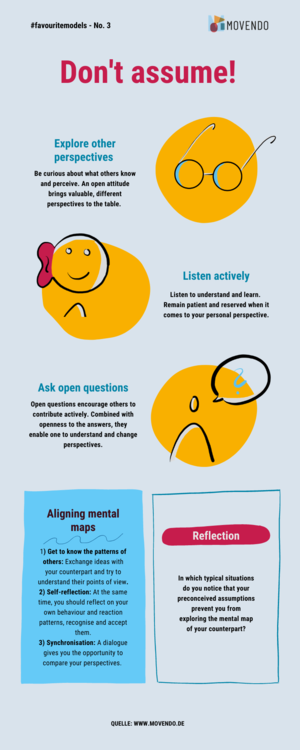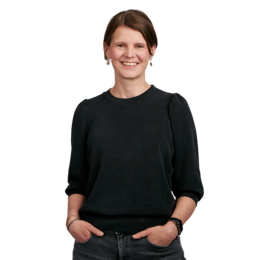#favouritemodel No. 3 - Don't assume

Different information, different interpretations, different perspectives. On our way, we learn very early on to reflect knowledge and to show that we know something about a topic. With an open attitude, however, in which we do not make assumptions, the first step is more about finding out what the other person's perspective is like, what the other person knows or thinks. This is an attitude that needs a little practice.
So if I make it a habit to actually find out what exactly my counterpart perceives and interprets, sees and knows, then I come much closer to a common mental map, a comparison of the respective ideas or levels of knowledge. In our idea of cooperation, it is indispensable to explore and understand the perspectives of the other person.
In his book "Seven Ways to Effectiveness", S. Covey talks about "first understanding, then being understood". This is exactly what it is about when, on the one hand, I always assume as a basic principle that different perspectives exist and, on the other hand, I want to bring the mental maps together.
An understandable challenge at this point is the time investment needed to ask, listen and understand. It takes a bit of practice to first put aside one's own views, especially as a leader, and be open to the information of my dialogue partner. In the best case scenario, I have become accustomed to asking open questions and actively listening in order to learn and understand as much as possible. I signal my interest by summarizing what I have heard and by asking questions of understanding.
Interlocutors whom I meet with interest and openness feel taken seriously, heard and can thus contribute through their perspective. The wonderful side effect, once I get into the habit of this approach, is in most cases a very trusting interaction in which my colleagues and staff experience the clear benefit of "don't assume" and, at best, make it a habit as well. Asking open questions and being open to the answers means understanding and being able to change perspectives. And I wouldn't want to miss any of this in a work environment.
How does my #favouritemodel help you?
If you notice in a conversation that you have already described your point of view several times, but somehow it doesn't seem to be getting through, then it is usually high time to change perspectives and find out how a certain situation looks to your counterpart.
Instead of repeating your opinion or view even more clearly or perhaps even louder, it is always worth listening first.
Especially as a leader, this is a so-called "SuperPower" and "SuperDuty" at the same time. Listening to the knowledge and/or opinions of your employees, collecting them and then, at best, making them transparent for everyone is one of the core tasks here. And this actually works mainly by first listening to the others and encouraging them to contribute by asking open questions.











